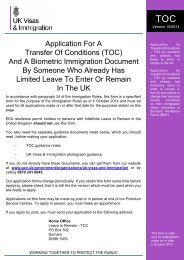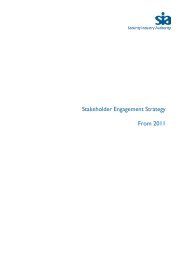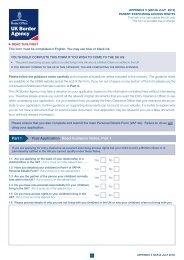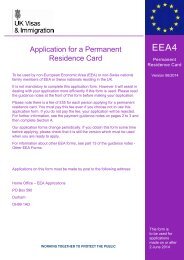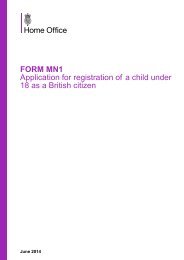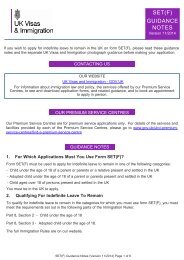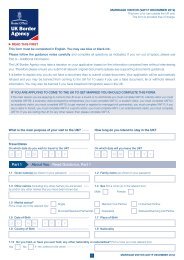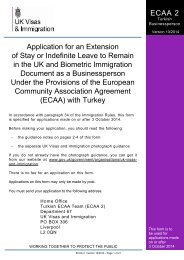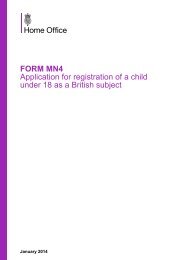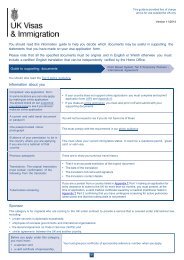Full Regulatory Impact Assessment for Manned Guards & Keyholders
Full Regulatory Impact Assessment for Manned Guards & Keyholders
Full Regulatory Impact Assessment for Manned Guards & Keyholders
Create successful ePaper yourself
Turn your PDF publications into a flip-book with our unique Google optimized e-Paper software.
the SIA should be self-financing and it would not be appropriate to use public funds tosubsidise regulation of the industry, or to use regulation to raise public funds from theindustry. The level of the fee <strong>for</strong> the granting of an SIA licence is there<strong>for</strong>e determinedby the cost of operating the regulatory scheme, including the cost of running theAuthority, and the demand <strong>for</strong> licences. The variables tested by the three optionalapproaches – the standards of criminality and competency that will be required in orderto gain an SIA licence – would not entail different procedures within the Authority thatwould lead to a change in the overall cost of the scheme or in the level of the licencefee. Option 1 however, might have the effect of deterring fewer people with criminalrecords from applying <strong>for</strong> a licence, thereby increasing demand and reducing the unitcost of a licence.5.4 The application fee <strong>for</strong> an SIA licence (which will be valid <strong>for</strong> three years) iscurrently set at £190; this includes the cost (£28) of obtaining a Disclosure from theCriminal Record Bureau (CRB). It has always been the Home Office’s intention that theSIA should be self-funded by means of the charges that it makes to those who use itsservices, and that it should not be a drain on taxpayers. The licence fee has there<strong>for</strong>ebeen set at the level necessary to meet the full cost of running the SIA. This includesnot only the direct cost of processing licence applications, but also the Authority’s otherrunning costs relating to, <strong>for</strong> example, its investigations and compliance function. Thisfee level will be used in the costing of each of the options.5.5 Earlier this year the SIA was able to secure an agreement with the InlandRevenue that the licence fee would be tax deductible. This means that whereemployees in the private security industry pay their own licence fee, they will be able toclaim tax relief against their taxable income. There will also be no tax or NationalInsurance liability where an employer pays the fee on behalf of his employees. Foremployees paying tax at the basic rate, this is worth £41.80.5.6 The analysis also assumes that the application process would be the same, orvery similar, <strong>for</strong> each option. Variations in the criteria to determine applications wouldnot affect the process. Licence application time is only relevant as a cost to industrywhere the applicant is currently employed in the sector and would not be able tocontinue employment until a full SIA licence was granted and where insufficient timewas allowed <strong>for</strong> the application to be processed be<strong>for</strong>e the regulations came into effect.The SIA communication strategy will aim to minimise the percentage of lateapplications. Where relevant, application time is calculated as the average number ofhours worked in the period of time it takes to receive the licence multiplied by theaverage hourly wage.5.7 Training costs will fall most heavily on new entrants to the industry since someexisting qualifications can be transferred <strong>for</strong> a much smaller cost. The SIA estimatesthat training will cost between £250 - £350. For the Cash and Valuables in Transit(CVIT) sector, the vast majority of existing staff are likely to be fully exempt owing toprior training qualifications. Again <strong>for</strong> the new staff and those not fully exempt, it isbelieved the cost of training is likely to be met by the medium to large companies.5.8 Current CCTV Public Space Surveillance staff are likely to have to undertaketraining to pass the assessment and get the SIA approved qualification. There may besome part exemptions against the training requirement <strong>for</strong> practical skills although in14



